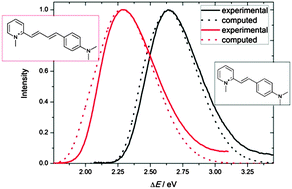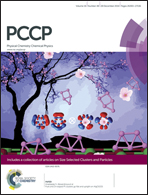An integrated computational tool to model the broadening of the absorption bands of flexible dyes in solution: cationic chromophores as test cases†
Abstract
This paper is devoted to the development and application of an effective computational approach for the prediction of band broadening in the electronic spectra of semi-flexible organic molecules in solution. The protocol is based on DFT, TD-DFT, and PCM computational techniques and attempts to take into account the three main contributions tuning electronic spectra, namely vibronic transitions, conformational equilibria, and solvent relaxation. The whole procedure has been implemented in the Gaussian code and has been tested for the interpretation of the spectroscopic behaviour of a betainic dye and a series of charged dyes, containing one methyl-pyridinium or quinolinium group and a flexible moiety. The results provide a comprehensive picture of solvatochromic effects and offer a reliable answer to the open problem of the origin of band broadening in the target semi-flexible dyes.



 Please wait while we load your content...
Please wait while we load your content...